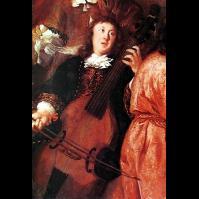-
Posts
324 -
Joined
-
Last visited
-
Days Won
16
Jean Szulc last won the day on June 18 2022
Jean Szulc had the most liked content!
About Jean Szulc

- Birthday 06/24/2001
Profile Information
-
Gender
Male
-
Location
Brazil
-
Occupation
Composer
-
Favorite Composers
Camargo Guarnieri, Charles Ives, Ravel
-
My Compositional Styles
Does anyone really enjoy filling in this part?
-
Notation Software/Sequencers
Sibelius
-
Instruments Played
Electric Guitar, starting on Piano and Clarinet.
Recent Profile Visitors
4,068 profile views
Jean Szulc's Achievements
-

String Sextet in G-flat major, 1st movement
Jean Szulc replied to Henry Ng Tsz Kiu's topic in Chamber Music
Beautiful work, @Henry Ng Tsz Kiu ! It was nice receiving on my email that you had mentioned me in a post, an coming here to see you were inspired by my work. Congratulations on a very expressive first movement, it is very soothing throughout, and seems consistently well written. I like the central section, in minor - the contrast was very much needed in my opinion, and it was refreshing when it arrived. The themes sound really nice, which for your style is really important, so congratulation on that aspect aswell. I don't understant why the pizzicatos are also notated with stacatto markings, and sometimes even with stacattissimo. It's not like you could control the duration of a stacatto anyways (technically you could, by raising the finger off the fingerboard before the sound died off, but it's not like it would make much of a difference either), so I would just remove the stacatto markings throughout. Unless you have a precise reason why you did it, of course. In that case, notate it on the beginning of the score so that there will be no confusion on the part of the performers. Also, some slurs are way too long. For exemple on M.79. When writing for strings, don't forget that slurs indicate bow changes. As a fan of chinese music, and of Qigang Chen in particular, I loved to hear your sextet. I'm very interested in hearing your second movement, and in where you take this. I personally feel like we need a big contrast next, given that the first movement is already very continuous in its writing. But of course, this is for you to decide :) Good luck! -

Variations on "London Bridge..."
Jean Szulc replied to PeterthePapercomPoser's topic in Piano Music, Solo Keyboard
Exactly my first thoughts when I saw the title, but I also came to the same conclusion. This often sounds beautiful... and when it doesn't, it sounds psychotic, which usually is even better! -
Gwendolyn Przyjazna started following Jean Szulc
-
Hey @Henry Ng! Thank you very much for your comment! It makes me really glad to know you could extract some knowledge from my music :) I was also inspired by many works in this forum before, and its nice to know that what I write can do the same for others. Good luck on your work :)
-
Great work as always man! I totaly agree with @Thatguy v2.0, expand the stuff your write! Form is so crucial for a work to stand on its own. Not investing the time into making sure the form works is like trying to make a sandwich but forgetting to buy bread. You already got the material, so it shouldn't be too hard taking the next step. And even if it is, it'll be worth it :) Please buy that bread.
-
Thank you very much @JWNewton for your feedback! It's lovely to hear your appreciation :) Hey there, @Alex Weidmann! Thank you for your feedback :) Well, the way I did it you'd have to know how to notate harmonics by hand. I used solely Sibelius and NotePerformer 3 to produce this, so I don't think there would be another way around it. That being said, it's not hard to do it at all. You would just have to follow a table like this one: https://en.wikipedia.org/wiki/File:Artificial_harmonic.png Good luck!
-
@Markus Boyd Thank you very much! I'm grateful you enjoyed the work and I thank you for subscribing. I hope to post a lot more soon ;) @Quinn Thank you very much for you comment! About the fugue, I used a single theme, however I came up with a scheme to use all 8 instruments in a contrapunctal setting: Each pair of instruments (Violins 1 and 3, 2 and 4, Violas and Cellos) enter and stick together. That is, the 2nd violin introduces the subject, and the the 4th violin the answer. After they both had it's appearance, they start playing in a sort of free canon. In a way, they become intertwined into a single voice. Then, the violin 1 and 3 do the same thing, then de cellos, then the violas. That's the exposition. Ultimately, I end up with a four voice cointerpoint that is doubled canonically, which allows me to have the sound of an 8-voice counterpoint without necessarily having to write an 8-voice fugue. About the rhythms, I guess this is one the main aspects that drive my music. I feel like you can almost get away with anything if the notes that are being played are being played at the right time. Emphasis on right time. Rhythm is just so powerful in driving music forward! Thanks once again for your very thoughtful comment! All your thoughts were really insightful to me :) @PeterthePapercomPoser Thanks for your thoughts and comment! It's always great to read that someone enjoyed your music :) I haven't notated any Bartok Pizz, but there are quite a few FF and FFF passages that might give off a close result.
-
I have absolutely nothing to add, but I wanted to say I find this very evocative indeed. Actually, just thought of something to add . The language of this work sounds very fresh, yet very antique in a way. I don't know, I couldn't exactly place it in time if I wanted to. It doesn't sound old, nor new. This is in no way a problem, it can even be a huge upside. But I think if you wanted to explore this language further, you could maybe find something that would make it undeniably contemporary. Undeniably you. I don't know, it's a complex subject. Once again, this is in no way a problem. But because I like this piece so much, I kind of hope you'll discover a whole universe while watching this night sky you've created. I would certainly like to listen to each of its individual stars.
-

Nocturne impov. looking for comments
Jean Szulc replied to JupiterSwears's topic in Piano Music, Solo Keyboard
I agree with @PeterthePapercomPoser on all his remarks. If I could add one little thing, I think the music could benefit from a bit more space in the melodic line. There are a lot of moments in which you have at least one note on each beat non-stop. This is not wrong, but diversity is always good and can make for a more effective line. Good job nonetheless. -

Rename it to Art of Canon or stick with the original title?
Jean Szulc replied to caters's topic in Composers' Headquarters
Well, yes, but I don't think the right approach here is "what do I need to fix". If I were you (especially given that you are taking up a huge project - to write something at the image of one of music's greatest tour de force's) I would simply re-write this canon. There are quite a lot of parallel and direct octaves and fifhts, there are a lot of dissonances that aren't prepared nor left correctly, and a lot of the melodic material isn't very recognizable - that is, they are simply alternating thirds or a scale going up or down. Moreover, the passages that do not include any problems do so usually by playing parallel thirds all the way, which is not wrong but is less musically-insteresting because it reduce the individuality of each voice. If you are not convinced it's not exactly just a matter of fixing the problems, litterally the first note of the second voice is a dissonance that isn't handled correctly. It creates a perfect fourth right at the first beat, that is left by a skip a third up. So basically a double mistake. All of this might seem like details, but in this type of music it is basically what separates a masterpiece from a student's exercise. A canon is a lot harder to write than it seems. If you do decide to re-write it, do it very slowly. For every note you put on the page, you need to consider exactly what repercussions will happen down the line - which is especially true in a canon. That's just how counterpoint is. It rubs your flaws in your face. I really, really don't mean to discourage you. I say all of this just to put into perspective the challenge you are going against, so that you can really evaluate where you are currently at. Pick up a book in conterpoint, and do the easiest exercises. You'll realise that even the easy ones will put up a fight! -

Rename it to Art of Canon or stick with the original title?
Jean Szulc replied to caters's topic in Composers' Headquarters
Hello there! An important question: what set of rules are guiding your canon? Is it supposed to be written in strict baroque counterpoint? Because if that's the case, you already have various details you have to fix. If not, maybe try defining some guidelines for yourself, so that the canon does note become a simple "copy-paste" of a melodic line. Good luck! -
Thanks for your thougths, @Tónskáld! It's great to hear that it pleases you :) It's interesting that you mention some South Americaness in it, because I honestly didn't consider it for a second. It's certainly impossible to not be influenced by one's heritage though, so I guess some of it might be at play here indeed! Thank you once again for your thoughts, it's always great to listen the words of someone you admire ;) Best, Jean.
-
Jean Szulc started following Jean Szulc - String Octet
-
Hey everyone! It's been a really long time since I don't post my music here. I thought I'd might share something I've finished quite recently. It's a string octet which hasn't been performed yet, but that hopefully will be later this year. I won't say much about it, besides that it is divided in three movements with a Fast-Slow-Fast general scheme. All feedback is encouraged, and I thank you for listening in advance !
-
I love this dude... I just hope you'd write longer stuff. I would listen to this for daysss, but its so short it leaves me wanting more!! About the piece itself, I think its well balanced, very evocative, all the good stuff. Keep at it dude!
-

Violin Concerto (WIP)
Jean Szulc replied to Tónskáld's topic in Incomplete Works; Writer's Block and Suggestions
Hey friend! It's been way too long since we last talked, its great that I decided to join the forum once again in a long time just now that you posted your wip. How have you been :) ? I love how its going, it sound very evocative and would be very pleasing to listen to in a live setting. I honestly don't have much to say much about the music simply because... I want to see where it goes! It's a great start, and I was very entertained during all times, so just keep at it and keep us posted :) -
Hey there! I agree with @PeterthePapercomPoser on all accounts - the piece is indeed pleasant to listen to! I would just maybe add that it would be interesting more contrast throughout. Maybe a section in which just two of the instruments play (it could last just for a couple bars, it would already help the piece breathe a bit). Just a detail - that is completely up to you to decide on - maybe some slurs could be notated differently for a better effect. For exemple the line that is played by the bassoon on measure 36, then by the clarinet. Do you want the bassoon to play it articulatin every single note, and the clarinet to play legato throughout? Also, maybe you could accentuate the playfulness of the idea by not adding a slur through the whole measure, but just before the stacatto notes, for exemple. Just something to think about. Good work!











.thumb.png.8b5b433a341551e913a34392660bc95b.png)




